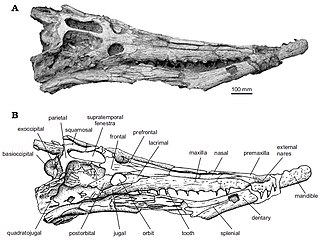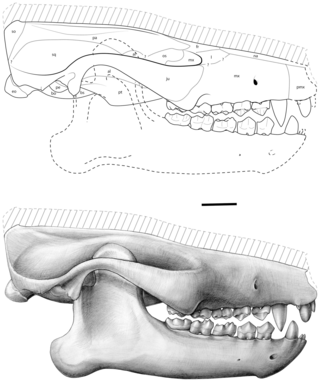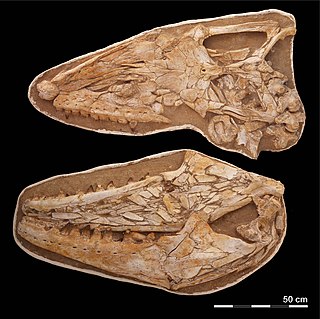
Proboscidea is a taxonomic order of afrotherian mammals containing one living family (Elephantidae) and several extinct families. First described by J. Illiger in 1811, it encompasses the elephants and their close relatives. Proboscideans include some of the largest known land mammals. The largest land mammal of all time may have been a proboscidean; the elephant Palaeoloxodon namadicus has been estimated to be up to 5.2 m (17.1 ft) at the shoulder and may have weighed up to 22 t, surpassing the paraceratheres, the otherwise largest known land mammals, though this estimate was made based on a single fragmentary femur and is speculative. The largest extant proboscidean is the African bush elephant, with a record of size of 4 m (13.1 ft) at the shoulder and 10.4 t. In addition to their enormous size, later proboscideans are distinguished by tusks and long, muscular trunks, which were less developed or absent in early proboscideans.

The Desmostylia are an extinct order of aquatic mammals native to the North Pacific from the early Oligocene (Rupelian) to the late Miocene (Tortonian). Desmostylians are the only known extinct order of marine mammals.

Anancus is an extinct genus of "tetralophodont gomphothere" native to Afro-Eurasia, that lived from the Tortonian stage of the late Miocene until its extinction during the Early Pleistocene, roughly from 8.5–2 million years ago.
Numidotheriidae is an extinct family of primitive proboscideans that lived from the late Paleocene to the early Oligocene periods of North Africa.

Daouitherium is an extinct genus of early proboscideans that lived during the early Eocene some 55 million years ago in North Africa.

Numidotherium is an extinct genus of early proboscideans, discovered in 1984, that lived during the middle Eocene of North Africa some 46 million years ago. It was about 90-100 cm tall at the shoulder and weighed about 250-300 kg.

Chenanisuchus is a genus of dyrosaurid crocodyliform from the Late Cretaceous of Mali and the Late Palaeocene of Sidi Chenane in Morocco. It was described in 2005, after expeditions uncovered it in 2000.

Dyrosauridae is a family of extinct neosuchian crocodyliforms that lived from the Campanian to the Eocene. Dyrosaurid fossils are globally distributed, having been found in Africa, Asia, Europe, North America and South America. Over a dozen species are currently known, varying greatly in overall size and cranial shape. A majority were aquatic, some terrestrial and others fully marine, with species inhabiting both freshwater and marine environments. Ocean-dwelling dyrosaurids were among the few marine reptiles to survive the Cretaceous–Paleogene extinction event.

Arambourgisuchus is an extinct genus of dyrosaurid crocodylomorph from the late Palaeocene of Morocco, found in the region of Sidi Chenane in 2000, following collaboration by French and Moroccan institutions, and described in 2005 by a team led by palaeontologist Stéphane Jouve. Arambourgisuchus was a large animal with an elongated skull 1 meter in length.
Argochampsa is an extinct genus of eusuchian crocodylomorph, usually regarded as a gavialoid crocodilian, related to modern gharials. It lived in the Paleocene of Morocco. Described by Hua and Jouve in 2004, the type species is A. krebsi, with the species named for Bernard Krebs. Argochampsa had a long narrow snout, and appears to have been marine in habits.

Notiomastodon is an extinct genus of gomphothere proboscidean, endemic to South America from the Pleistocene to the beginning of the Holocene. Notiomastodon specimens reached a size similar to that of the modern Asian elephant. Like other brevirostrine gomphotheres such as Cuvieronius and Stegomastodon, Notiomastodon had a shortened lower jaw and lacked lower tusks.

Eritherium is an extinct genus of early Proboscidea found in the Ouled Abdoun basin, Morocco. It lived about 60 million years ago. It was first named by Emmanuel Gheerbrant in 2009 and the type species is Eritherium azzouzorum. Eritherium is the oldest, smallest and most primitive known elephant relative.

Ocepeia is an extinct genus of afrotherian mammal that lived in present-day Morocco during the middle Paleocene epoch, approximately 60 million years ago. First named and described in 2001, the type species is O. daouiensis from the Selandian stage of Morocco's Ouled Abdoun Basin. A second, larger species, O. grandis, is known from the Thanetian, a slightly younger stage in the same area. In life, the two species are estimated to have weighed about 3.5 kg (7.7 lb) and 10 kg (22 lb), respectively, and are believed to have been specialized leaf-eaters. The fossil skulls of Ocepeia are the oldest known afrotherian skulls, and the best-known of any Paleocene mammal in Africa.

The Oulad Abdoun Basin is a phosphate sedimentary basin located in Morocco, near the city of Khouribga. It is the largest in Morocco, comprising 44% of Morocco's phosphate reserves, and at least 26.8 billion tons of phosphate. It is also known as an important site for vertebrate fossils, with deposits ranging from the Late Cretaceous (Cenomanian-Turonian) to the Eocene epoch (Ypresian), a period of about 25 million years.

Abdounodus is an extinct genus of mammal known from the middle Paleocene of northern Africa. The sole species, A. hamdii, is known from teeth discovered in the Ouled Abdoun Basin of present-day Morocco in 2001. Traditionally considered a mioclaenid "condylarth", recent studies place it as a basal afrothere closely related to Ocepeia, demonstrating the close convergent evolution between perissodactyls and herbivorous afrotheres and bridging paenungulates with other afrotheres.
Saloumia is an extinct genus of the order Proboscidea. It is one of the oldest members of the order and lived in the middle Eocene of Senegal. It is known only from a single molar, whose pronounced bumpy chewing surface indicates it is probably closely related to Moeritherium.
Dagbatitherium is an extinct genus of proboscideans. So far a single molar from the phosphate basins of Togo in West Africa has been found. The fossil dates to the Middle Eocene, around 47 million years ago. A striking feature of the tooth are the three pairs of cusps oriented transversely to the longitudinal axis of the tooth. This feature is found in more derived proboscideans, which are grouped in the Elephantiformes. For its age, Dagbatitherium is the earliest member of Elephantiformes to date. Furthermore, it is characterized by a low tooth crown and a humped occlusal pattern. The genus was described in 2021.

Thalassotitan is an extinct genus of large mosasaurs that lived during the late Maastrichtian of the Cretaceous period in what is now Morocco, around 66 million years ago. The only known species is T. atrox, described in 2022 from fossils discovered in the Ouled Abdoun Basin, where many other mosasaurs have been found. It was assigned to the tribe Prognathodontini alongside other mosasaurs like Prognathodon and Gnathomortis. The prognathodontines are separated from other mosasaurs based on their massive jaws and robust teeth.
Hadrogeneios is an extinct genus of afrotherian mammal recovered from the Khouribga Phosphates of the Ouled Abdoun Basin dating from the Selandian to the Thanetian. Only the type species H. phosphaticus is known for this genus, with the material being of dental and jaw specimens. The placement of Hadrogeneios recovered it to be the most basal stem-paenungulate, the clade that includes elephants, sea cows, and hyraxes. Despite this Hadrogeneios was a contemporary of more derived members of the group such as Abdounodus, Ocepeia, and the early proboscideans Eritherium, Phosphatherium, and Daouitherium.
Grand Daoui is a quarry in the Ouled Abdoun Basin of Morocco known for its fossils. It is the discovery place of Phosphatherium escuilliei, the earliest known proboscidean. It was the location for several field parties between 1997 and 2001, which allowed survey of the geological and paleontological context of Phosphatherium localities. It is also rich in marine vertebrae fossils. All Phosphatherium remains to date have been found in the quarry. The discovery of fossils there has aided in the study of early African placental fauna. The marine snake Palaeophis maghrebianus is also known from the locality, as well as the primitive gavialoid Argochampsa krebsi.




















